Every week, the Hackaday tip line is bombarded with offers from manufacturers who want to send us their latest and greatest device to review. The vast majority of these are ignored, simply because they don’t make sense for the sort of content we run here. For example, there’s a company out there that seems Hell-bent on sending us a folding electronic guitar for some reason.
At first, that’s what happened when CoolingStyle recently reached out to us about their Cooler Max. The email claimed it was the “World’s First AC Cooler System For Gaming Desktop”, which featured a “powerful compressor which can bring great cooling performance”, and was capable of automatically bringing your computer’s temperature down to as low as 10℃ (50°F). The single promotional shot in the email showed a rather chunky box hooked up to a gaming rig with a pair of flexible hoses, but no technical information was provided. We passed the email around the (virtual) water cooler a bit, and the consensus was that the fancy box probably contained little more than a pair of Peltier cooling modules and some RGB LEDs.
 The story very nearly ended there, but there was something about the email that I couldn’t shake. If it was just using Peltier modules, then why was the box so large? What about that “powerful compressor” they mentioned? Could they be playing some cute word games, and were actually talking about a centrifugal fan? Maybe…
The story very nearly ended there, but there was something about the email that I couldn’t shake. If it was just using Peltier modules, then why was the box so large? What about that “powerful compressor” they mentioned? Could they be playing some cute word games, and were actually talking about a centrifugal fan? Maybe…
It bothered me enough that after a few days I got back to CoolingStyle and said we’d accept a unit to look at. I figured no matter what ended up being inside the box, it would make for an interesting story. Plus it would give me an excuse to put together another entry for my Teardowns column, a once regular feature which sadly has been neglected since I took on the title of Managing Editor.
There was only one problem…I’m no PC gamer. Once in a while I’ll boot up Kerbal Space Program, but even then, my rockets are getting rendered on integrated video. I don’t even know anyone with a gaming computer powerful enough to bolt an air conditioner to the side of the thing. But I’ve got plenty of experience pulling weird stuff apart to figure out how it works, so let’s start with that.
Promising Pedigree
While I waited for my Cooler Max to make its way across the ocean, I decided to look a bit into the company itself. Browsing their website, you’ll find an impressive array of diminutive water chillers used for things like cooling industrial lasers or high-performance servers. As explained on the website, the key to CoolingStyle’s product line is their palm-sized compressor, which lets them squeeze an entire refrigeration system into a box that can fit into a standard server rack.
Pulling the manual for one of their chillers, we can see that the control panel used is identical to the one shown in the promotional images for the Cooler Max. At this point, I was actually getting pretty excited — this thing was looking more and more like the real deal.
In fact, one of the chillers offered on the CoolingStyle, the Q Series Micro Water Chiller, appeared to be very similar to the overall layout of the Cooler Max. Could it be that this company took one of their high-end industrial cooling devices, retooled it for the gamer crowd with some RGB LEDs?
An Imposing Machine
I have to admit, as soon as I got the Cooler Max out of the box, I was impressed. The thing is as large as a mid-sized desktop PC, and is built like a tank. There are a few fit and finish issues here and there with the case, but nothing that can’t be forgiven considering it’s a pre-release prototype.
In terms of construction, it’s actually very similar to a desktop PC case, with sheet metal side panels that slide off once you remove the rear thumbscrews. The front and back panels are also sheet metal, while the top and bottom appear to be injection molded plastic. In fact, I wouldn’t be surprised if it’s some kind of jellybean PC case that’s been customized, as there’s even a support panel on one side that looks like it could have been intended to hold a motherboard.
Electronics
Towards the front of the Cooler Max is a Mean Well LRS-350 power supply providing 24 V to the compressor and most of the electronics, and around the other side we can see a common adjustable regulator board that’s been set to 5 V and is connected to the dual 120 mm RGB fans in the top of the unit. As the main control board for the compressor has a functional 5 V rail already, the addition of the separate regulator seems to be a bit of a bodge; as if the onboard regulator wasn’t up the task of handling the large light-up fans. In any event, I’d be surprised if this wasn’t changed for the production units — even just dropping down to a fixed 5 V regulator would be cheaper.

The compressor control board has quite a bit going on, and judging by all the unused connectors, has considerable untapped potential. There’s clearly a serial port right at the top of the board, which could be a subject of future experimentation. Overall the construction looks quite nice here, and I appreciate the little details like the insulated spade connectors. The relays could be a point of potential failure down the line, and though they aren’t socketed, swapping them out wouldn’t be terribly difficult.
On the inside of the front panel, we have a second PCB. This is the one that appears to be featured in most of CoolingStyle’s products, so as you might expect, it again features a number of unused connections considering this relatively simple application.
While the two main ICs have regrettably had their labels removed, the pair are obviously a microcontroller and a dedicated LCD controller. Note the clearly marked SWDIO/SWCLK pins on the bottom header: that’s a Single Wire Debug (SWD) interface, and a decent hint that our mystery MCU is in fact an STM32. Like the previously mentioned serial port, this interface is ripe for future experimentation. Matthew [wrongbaud] Alt has put together some excellent write-ups on the kind of information that can be gleaned from SWD, for those not familiar with ARM’s answer to JTAG.
The conformal coating on the board is a nice touch given the potential for moisture, and the screw terminal connection for the thermocouple was a welcome surprise. Small details, but they speak to the overall build quality.
Water Cooling System
 I won’t spend much time on this since, as far as I can tell, this part of the Cooler Max looks like it’s completely off-the-shelf. While I obviously don’t have one to compare against, I’d be surprised if this is the kind of thing you’d find in any of their professional chillers; and is likely one of the cost-cutting measures they’ve utilized to create this more consumer-targeted device.
I won’t spend much time on this since, as far as I can tell, this part of the Cooler Max looks like it’s completely off-the-shelf. While I obviously don’t have one to compare against, I’d be surprised if this is the kind of thing you’d find in any of their professional chillers; and is likely one of the cost-cutting measures they’ve utilized to create this more consumer-targeted device.
There are no identifying marks on the water cooling components, but very similar units can quickly be found online. There may have been some custom modifications done, for example adding the port for the thermocouple, but certainly the pump, fittings, and reservoir are all standard components that you’d find inside any water-cooled gaming PC. Not that there’s necessarily anything wrong with that.
Refrigeration Cycle
So at this point, it should be clear that the Cooler Max really is a tiny (relatively speaking) refrigeration unit. Just like an air conditioner, it’s got a compressor and a sizable condenser paired with large fans to keep it cool. But the difference is that, instead of blowing cold air, this device is designed to pump cold water.
So rather than an evaporator coil with another set of fans blowing across it, the Cooler Max uses a heat exchanger to cool the water that’s being pumped through the internal reservoir. Unfortunately the nature of the soldered copper connections on these sort of refrigeration units makes it impossible to take them fully apart without releasing the refrigerant, so we can’t get a very good look at any of these components in isolation.
But with the water reservoir removed, and the power supply moved to the side, we can get a fairly good overview of all the core components. The silver radiator in the rear is the condenser, the black cylinder mounted to the bottom of the case is CoolingStyle’s miniature compressor, and the foam-wrapped box at the center of the image is the heat exchanger. The thicker insulated tubes are for water, and if you look at the top of the image near where the AC power comes into the unit, you can see the bulge of the flow sensor which it used to determine how much water is actually being pumped through the system.
Impressively Repairable
Before wrapping things up, I think it’s worth noting that the Cooler Max is perhaps one of the most serviceable devices we’ve seen during this teardown series. Replacements for so many of the components, from all of the water cooling gear to the fans and power supply, can be picked up on your online retailer of choice without jumping through any hoops.
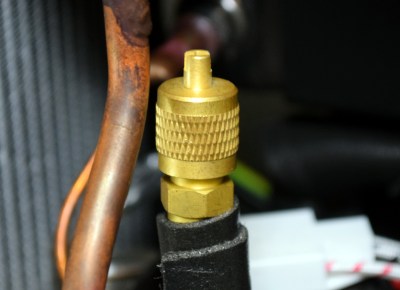
The design and construction of the unit is such that, as you’ve see here, it can be taken almost entirely apart with nothing more exotic than a screwdriver. All the electrical connections are socketed or screw-down, and there was’t a dab of glue anywhere to be seen inside the thing.
Incredibly, they even included a service port for adding refrigerant, which is something you generally have to hack in yourself. The compressor uses R134a, which at least here in the United States, you can simply pick up from the auto parts store.
Of course, being a prototype, some of these features could be due to its one-off nature. The final units might strip out the service port and replace half the internals with proprietary bits and bobs. Maybe. But we can dream.
OK, But Does It Work?
As I said at the start, I’m no PC gamer. Nor is this a website about PC gaming. So I’m not qualified to pass judgment on the Cooler Max in that context. That will likely upset some people, perhaps not least of which the fine folks at CoolingStyle.
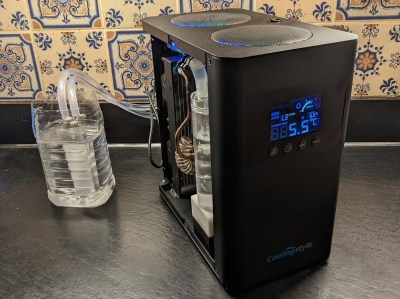
For the record however, I did hook it up to a basic water block to do some simple tests — it definitely gets cold in short order, and when I dunked the block into a bucket of hot water the Cooler Max revved up like mad and brought it down to below room temperature in a minute or two.
I can also tell you that the Cooler Max appears to be very well made, and designed so that you can open it up to fix it, and potentially modify it, without danger of destroying it in the process. That’s a trait we don’t see often enough, so respect to CoolingStyle where its due.
Considering there’s nothing else quite like it on the market, it’s hard to judge the introductory Kickstarter price of $699. It’s a lot of money. But the closest thing you can really compare it with on a technical level would be a small travel air conditioner, and shopping around, they cost just about as much. Of course, at the end of the day, if you’ve got a gaming computer powerful enough that you’re even contemplating something this elaborate for your cooling needs, that number probably isn’t going to break your budget.

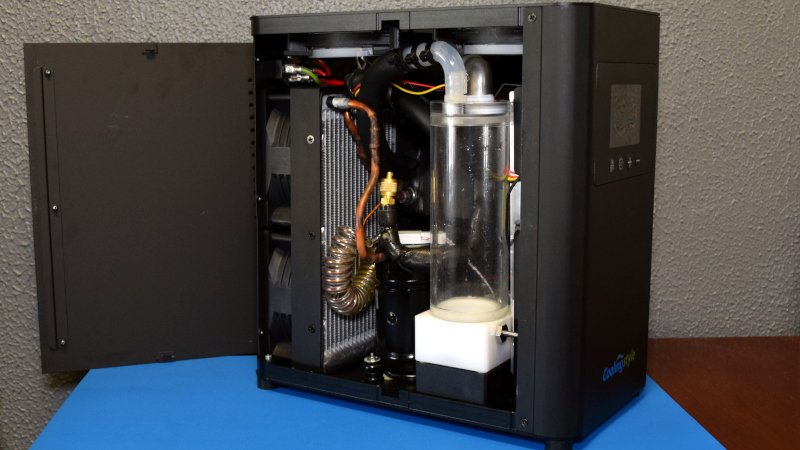


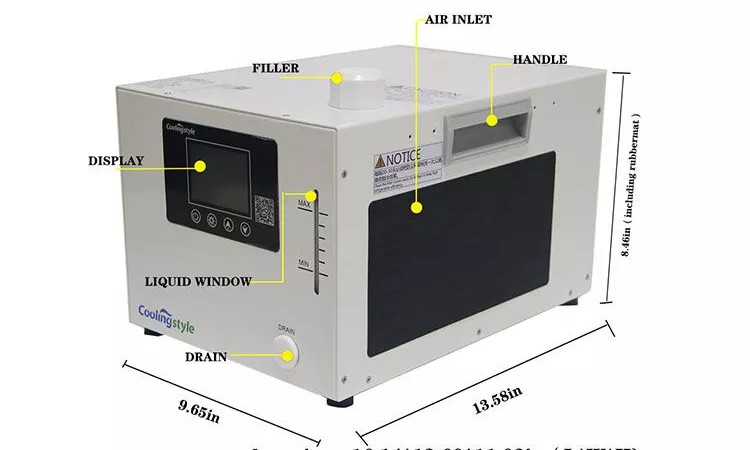



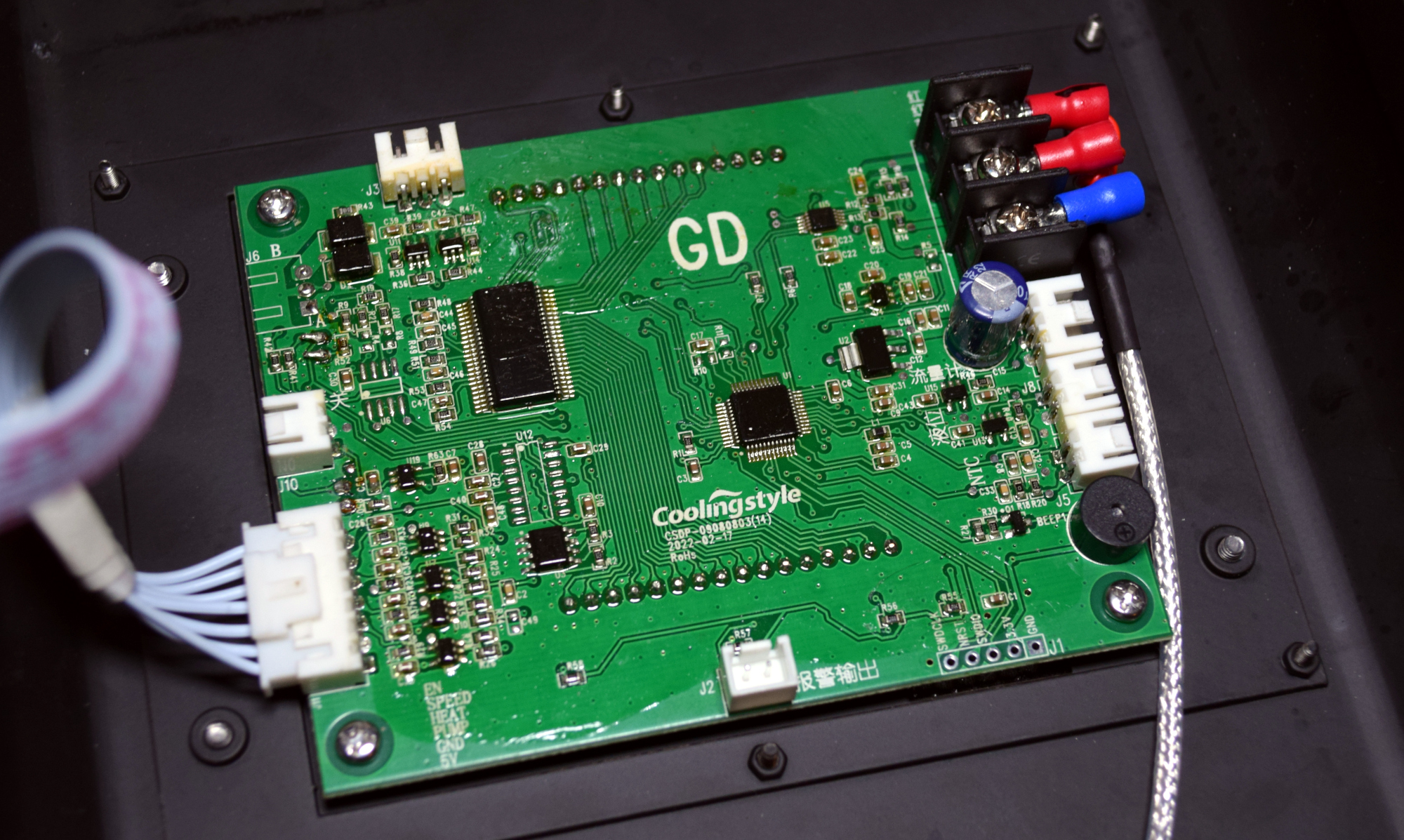
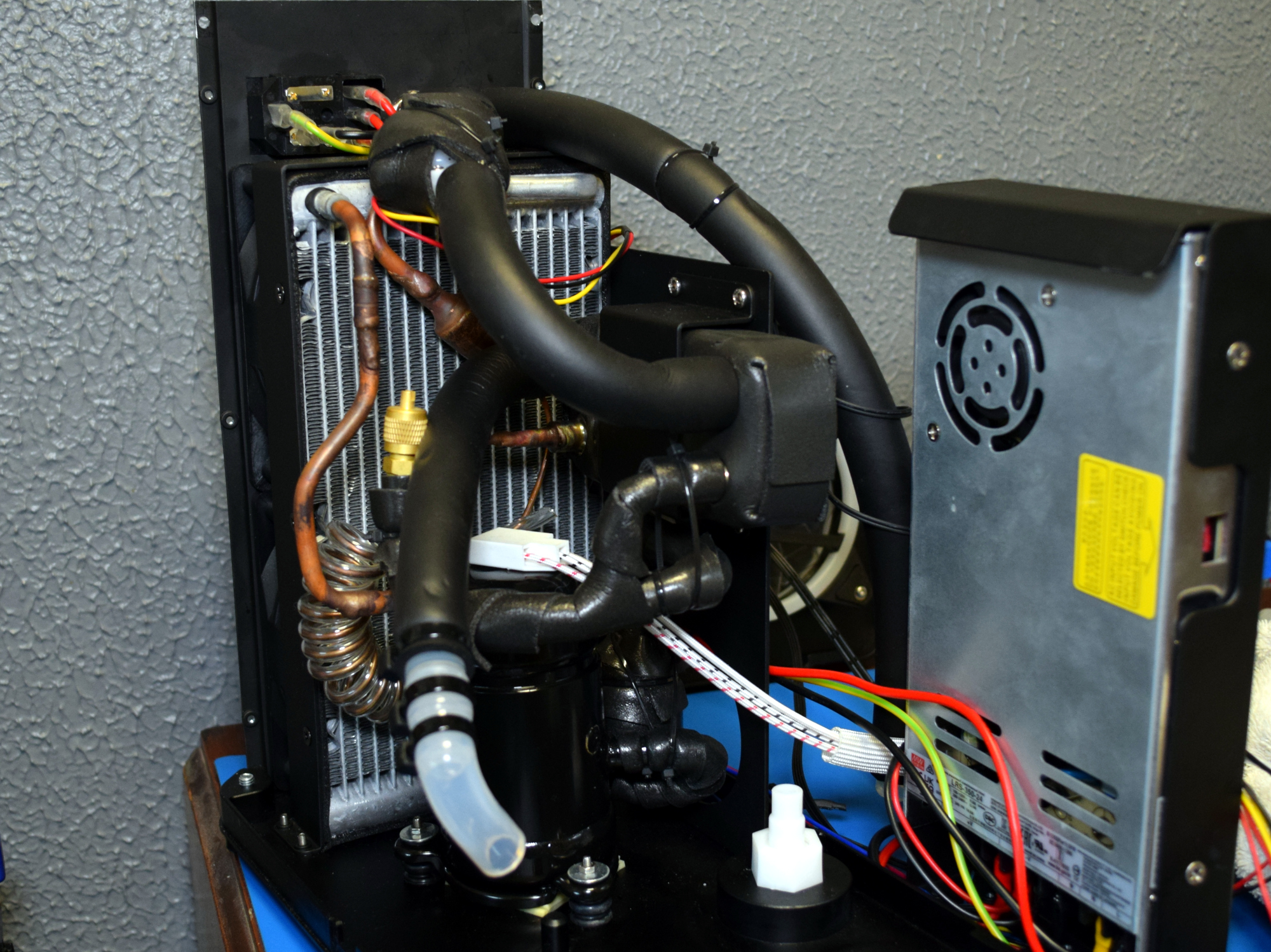















I wonder if it would work for water-cooled CNC spindles?
The ones I see usually have 2-4 times the cooling capacity and are a third as expensive. But this little desktop unit uses a lot less electricity and is more appropriate for just cooling off a cpu/gpu.
Depends on how much heat the spindle generates.
But why would you want that? Almost any motor is going to be perfectly happy at 150°F or more. You don’t need a heat pump to dump heat from a system that could be nearly 100° above ambient. The 3kW spindle on my router can barely even get warm when attached to a 2x120mm PC watercooling radiator. The total cost of the radiator, tubes, fans, and pump probably cost me less than what just that compressor would on its own.
> Almost any motor is going to be perfectly happy at 150°F or more.
No, they’re not. The bearings won’t like it, the tolerances will be wrong so it’ll wear faster, and so on.
Maybe, just maybe, manufacturers of spindles know something some incredulous hackaday reader doesn’t.
You want temperature controlled spindles so you can control the thermal expansion of the spindle and changes in bearing clearance so you can control spindle accuracy. You want to operate at a fairly narrow temperature range that matches the bearing preload. Even our PCB drilling mill has a thermally controlled spindle that won’t run until it’s in the right thermal range.
Seems it would be better to have the bulk of that outside the case. Easier to work with too.
World’s first seems a stretch, Cooler Express were selling these at least as far back as 2013?
yep, PC ac cooler dates back ages… “first gaming PC ac cooler” is a joke
Some guy playing Quake in the 90s certainly put his rig in a minifridge at some point. But this is a neat little packaging, obvious ad aside… Might be cool to put it in a backpack and hook it up to a scooter battery and one of those irrigated flight suits. Instant personal refrigeration
you doo realize that astek being selling such cooler since around 1999?
https://www.asetek.com/company/about-asetek/asetek-heritage-technology/vapochill/
so much for “world first”…
Better refrigerants back then too.
These aren’t similar at all. Did you even read the link you posted?
Do more research, that’s a completely different type of system.
I’m always glad to see a nice teardown write-up. I am no PC gamer myself, and have no interest in actually owning one of these things, but I’m always interested in how things work and how they are made.
One question does remain for me though. How much noise does it make?
Linus tech tips did a video on this project too. Its not exactly quiet.
I’d also worry about vibration.
I have an LRS-350 powering my 3D printer. When the fan kicks in, it’s the noisiest part of the machine.
This falls into the “pathological overclocking freak” range of cooling systems, not the “home theater media server” bit. I’d just wear headphones.
Once the compressor is running it sounds a lot like a window air conditioner, though obviously without the whoosh of air. Just the rumble.
As I sound I don’t find it terribly annoying, but it will likely be the loudest thing in the room once it gets going.
I think the loudest thing in the room will be the speakers hooked up to the gaming rig.
It’s priced at about 50% more than a CW5000 water chiller which have been on the market for years. They might want to rethink pricing or at least push what makes it that much better.
Well for one thing, the Cooler Max appears to be about 1/3rd the size and weight of the CW5000 from what I can tell.
It’s a shame that it runs on 24V not 12V, would be curious whether their mini compressor is powerful enough for use as a part of an aftermarket car air conditioning system
You can buy that type of compressor in 12V flavour with control board included straight from China. If I remember correctly they go up to around 600W.
This is the first thing I was thinking of.
There seems to be a complete lack of small 12v dehumidifiers on the market – there are crappy single-Peltier units that are near-useless, and that is it.
Adding a dehumidifier would potentially allow someone who drives an EV that lacks a heat pump (many of them currently on the market do – VW won’t even let US customers buy ID.4 units with a heat pump but will sell them to Canada) to dehumdify the cabin, allowing them to stick with recirc without fogging.
My Bolt can maintain cabin temps with 1-2 kW of heat on recirc, but that leads to fogging – periodically hitting defog disables recirc or runs the AC in a mode that dumps heat outside. Hitting defog will take the heater from 1-2 kW to pegging it at 7.5 kW to maintain the same temperature.
You might consider dessication dehumidification.
that really does NOT work in a car. especially when driving. the amount of moisture you bring in every time you open the doors would saturate it instantly in the kind of environments where you need the Defogger circuit
Or a personal air conditioning system, which might be better served by a 24v lithium battery pack (less current)
I’ve seen a vapor-phase cooling case before. I don’t know what’s new.
Meh, not a hack. Should not have clicked on it. : (
“World’s First AC Cooler System For Gaming Desktop”
What about Krotech’s beast of a system waaay back in ’99?
https://www.tomshardware.com/reviews/fastest-pc-kryotech,103-2.html
…and it looks like even Thermaltake were talking about one back in 2008:
https://www.hexus.net/tech/news/cooling/15541-thermaltake-xpressar-supercooled-system-gets-green-light/
ooo, and even a standalone system in 2004 by Asetek:
https://hexus.net/tech/reviews/cooling/790-asetek-vapochill-lightspeed-ac/
So, no, not the world’s first unless you’re too ‘yoof’ to care about the past :-/
I think what CoolingStyle is trying to say here is that this is the first real refrigeration system you can simply plug into an existing water-cooled setup and go. Previous systems relied on custom cases, or used a proprietary connection to the CPU.
With the Cooler Max, it just makes the water cold. What you do with the water after that is up to you. There are other devices like this in the industrial space (as pointed out in comment above, the CW-5000 is a solid comparison), but those clearly aren’t geared towards gaming PCs.
So their claim does perhaps hinge on a technicality (being marketed for gamers), but the technology is also far more applicable than those legacy attempts at refrigerating a PC.
I mean it seems like it’s more efficient to simply use the evaporation of the refrigerant to directly cool down the die instead of going through heat exchangers and a separate fluid medium, incurring efficiency losses. But at least you can get it to all the separate bits easily. That is definitely an advantage.
I guess you have the advantage here of not having to prep a board for subzero cooling, with all the risks that brings. Of course this is less performant.
Might be useful to cool my table top CNC mill …
I’d consider something like that for my K40 laser when the price drops down a little.
Looks more compact that the existing chillers I’ve seen and will certainly last some time as it won’t be running 24/7
$699 is a lot of money for a cooler limited to the freezing point of water.
We run chillers for peltier thermal control systems at work with a 50/50 glycol-water mix at -10C coolant temp 24/7. We paid an order of magnitude more for our noisy boi, but I don’t see why this wouldn’t work with a glycol mix too.
Falling back on the first part of “Hackaday” – the hack – how does this compare with a < $100 "dorm" size fridge from a big box store with a heat exchanger inside? Then you can keep your over-sugared/over-caffeinated beverages cold too. If blinky lights and fans are needed there would then be a budget for that too.
You could even get real fancy and run the evap coil from the fridge through a water block heat exchanger instead of just uh.. adding ATX form factor screw posts on the inside ;)
I mean, you could. But you’re not going to get nearly the same efficiency from a copper coil just sitting in a refrigerator as using a heat exchanger that’s in direct contact with the refrigerant.
Seems to be a respectable machine. I’d venture to say the HVAC system might be the killer component. Assuming you’re good enough with HVAC to be confident in your ability to change those out, the pump or heat exchanger might cost as much to replace as buying a new machine. That said, if replacing the purely HVAC parts is the worst failure that can make it more cost effective to buy a replacement, it’s not a bad little product. It’s just a bit niche for most people to buy into. Which, they’ve apparently accounted for, by focusing this on high-end gaming machines and the people who run them.
TL;DR: If this machine stays as repairable as the version they sent you, and the only parts that would cost as much as, or more than the assembled machine, are the HVAC parts, I agree with the article’s sentiment that this machine is respectable.
This reminds me of a truly archaic soda cooler that I saw many decades ago. The whole thing resembled a chest. The top part of the chest was a water bath into which the Beverages to be Cooled would be immersed. The lower part was home to the refrigeration machinery, that chilled the water bath above. By virtue of direct contact of beverage container to the chilled water, your soda would go from back-of-the-car hot to brain freeze inducing cold in mere minutes.
Those and recirculating water coolers with real compressor refrigeration were in demand by dual loop waterchiller experimenters around the turn of the millenium.
Where this technology came from was the US military put out a contract for a tiny refrigeration compressor, end use unspecified. The companies only needed the size and performance specifications.
After the compressors were developed, the project was abandoned so the companies who’d spent lots of money and time on the technology sold it for civilian use. Of course once a thing is demonstrated to be possible, other companies will make their own version.
On Ali Express one can get a complete micro refrigeration module. Hook up power and figure out your own ducting.
Adam Savage and some refrigeration tech built a functional cooling backpack from one of those tiny compressors. The intended use is for a spacesuit costume he’s building. He got overheated at one Comic-Con in an exact replica of the suits from “Alien”, and the ice backpack he made for another suit costume didn’t last very long.
Cruise N Comfort USA makes micro sized refrigerated air conditioning systems for 12v, 24v, and 48v.
…Was it really for the military? I thought it was just guts from a minifridge.
I think a mini fridge compressor is much bigger.
Just disassemble a truck compressor coolbox. Or go to aliexpress, search for 134a compressor 24v.
If you are blowing that amount of watts on hedonistic computing you should seriously reconsider your ecological credentials, or just stop pretending that it really matters. Otherwise, cool story bro.
>or just stop pretending that it really matters.
Exactly! It’s just pretending. It doesn’t really matter. At all.
The only people who claim that it matters are only do so for the virtue signaling aspect of feeling morally superior to those they look down on, and to cash in on social clout. Believing that it “really matters” is the epitome of a luxury belief that’s detached from reality.
Current greenthink says, I would be greener to run this than my furnace in this half of the year, since it burns fossil natural gas, and my electric is locallty heavily hydro and wind sourced.
Though if you’re not sitting in 5 sweaters and a pair of snowpants and are blowing X amount of watts on hedonistic heating you should seriously reconsider your ecological credentials.
Wait, so there’s a folding electronic guitar?
Inquiring minds want to know!
B^)
Here’s a hack:
Find a bottle type office water cooler that has a refrigeration unit.
One might be available cheap/free due to looking too grungy for cooling drinking water.
Coil pipes with a small pump running from a CPU into the water reservoir.
These nonsensical rigs are so tasteless and wasteful. Toys for paupers with more money than sense. It is really simple. If it needs many fans, massive heat sinks and bloody liquid cooling, the underlying technology is not ready for consumer use. Perhaps the odd supercomputer here or there, but every day people should not be able to get this nonsense.
Have a bit of patience and way a couple of years. The cost will be way down, the waste is less, the energy bill will be lower and you will not look like a complete Tw@t!
That is a silly way of thinking. The gaming hardware often also is used within the creative professional and hobbyist machines. When you can cut a rendering job down 25 or 50% (often many hours) by using these “tasteless and wasteful” rigs based on the latest hardware, I would counter that it is wasteful not to take advantage of it.
I’ve been around some of the top industrial chillers (SMC, Julabo, etc.) and can say that, by the looks of it, it’s on par with the >$10k machines that I maintain. The controller looks like any Omron or Automation Direct , though that screen certainly has more going on :) Fancy water coolers, LOL!